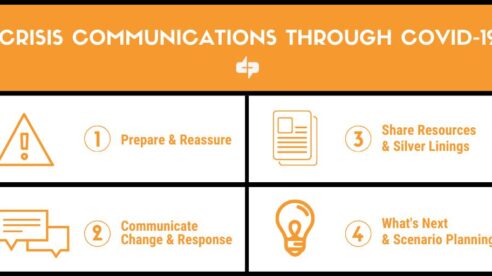For weeks, we’ve heard the call from elected officials and healthcare providers about the need to “flatten the curve” of the COVID-19 pandemic so as not to overwhelm the nation’s hospitals and medical facilities. As we head into early June, there is cautious optimism that the strategy has helped. The theory is that a flattened curve stretches the timeline of COVID-19 cases but avoids the more dramatic and dangerous spike of a concentrated number of cases at any single point in time.
As communicators, we can think of our work along a curve, too, although one that looks a bit different. With the right formula of consistency and frequency in the midst of a crisis like this, the communications curve ramps up quickly but then levels off at a new plateau somewhere in between the old and new “normal,” indicating a new benchmark for messaging to key audiences.
Since the early days of March, D+P has had a first-hand look at the decisions being made operationally within organizations, large and small, for-profit and not-for-profit, and have actively shaped the messaging to communicate those decisions on behalf of our clients. Across the board, the arc of communications has moved through four distinct stages so far:
Phase I: Prepare & Reassure
As global news about the novel coronavirus began to accelerate, many organizations began revisiting and adapting their own emergency and crisis response plans or, at a minimum, recognized the need to have one. In our role as communications counselors, we crystallized communications objectives, key constituencies, and primary messaging and found that, despite differences in brand categories or industries, very similar themes emerged, including the need to:
- Reassure audiences of the commitment to keep people safe as well as establishing protocols for reporting on any positive cases;
- Reinforce the organization’s active monitoring of all federal, state, and local directives; and
- Share broadly information related to prevention and symptoms of COVID-19
Phase II: Communicate Change & Response
Each day through mid to late March brought new updates from city and state governments and health agencies which meant organizations were faced with the prospect of pivoting quickly to close physical locations and “open” virtual ones. Messaging evolved quickly, too, to convey operational changes and guidance for moving work and brand experiences online. Common areas of emphasis included:
- Logistical how-to’s and tech support for making the transition to virtual work lives and consumer experiences
- Messages of solidarity – “we’re here for you,” “let’s stay connected while apart” and “we’re in this together”
- Reports of positive or presumed positive cases within specific communities
- Launch of relief funds to support especially hard-hit sectors and regions
Phase III: Share Resources & Silver Linings
With a few weeks of virtual working, learning, and consuming content of all stripes under our collective belts, for many organizations, a sense of “we’ve got this” began to emerge. Messaging evolved again to address:
- Resources for support, including guidance on managing physical and mental health and wellness, remote working tips, activities for engaging school-age children at home, etc.
- Promotion of emergency fundraising campaigns in the non-profit sector
- Shared stories of resilience and silver linings – healthcare staffs dancing, images of daily cheers for healthcare workers in New York City and other places, at-home pop up performances of all kinds, and growing volunteerism at food banks and other support organizations
Phase IV: What’s Next & Scenario Planning
With no way of knowing for certain when mandatory closures in cities and states will be lifted, organizations and brands are flexing their scenario-planning muscles. Messages of hope that we will resume in-person activities this summer or fall or beyond should be closely aligned with language that says “we’re exploring all options and will be swift and transparent with decisions.” Now, more than ever, advancing a continued sense of reassurance and active leadership is key.
In all phases and in all that is still to come, the voices that convey reassurance and resilience, genuine compassion for lives impacted and lost, and active planning for now and later are the ones breaking through as the authentic leaders we all want and need, especially now. As communicators, choosing direct platforms for those voices is important, and so is varying the medium for their messages to include video, podcasts, and compelling imagery. Lastly, we all need to be ready to move communications plans into higher gear to get in front of – and lead – major change management for key audiences in the weeks and months ahead.
Organizations and brands are communities of people. Good communication keeps a community united, and that is what we need now more than ever.


